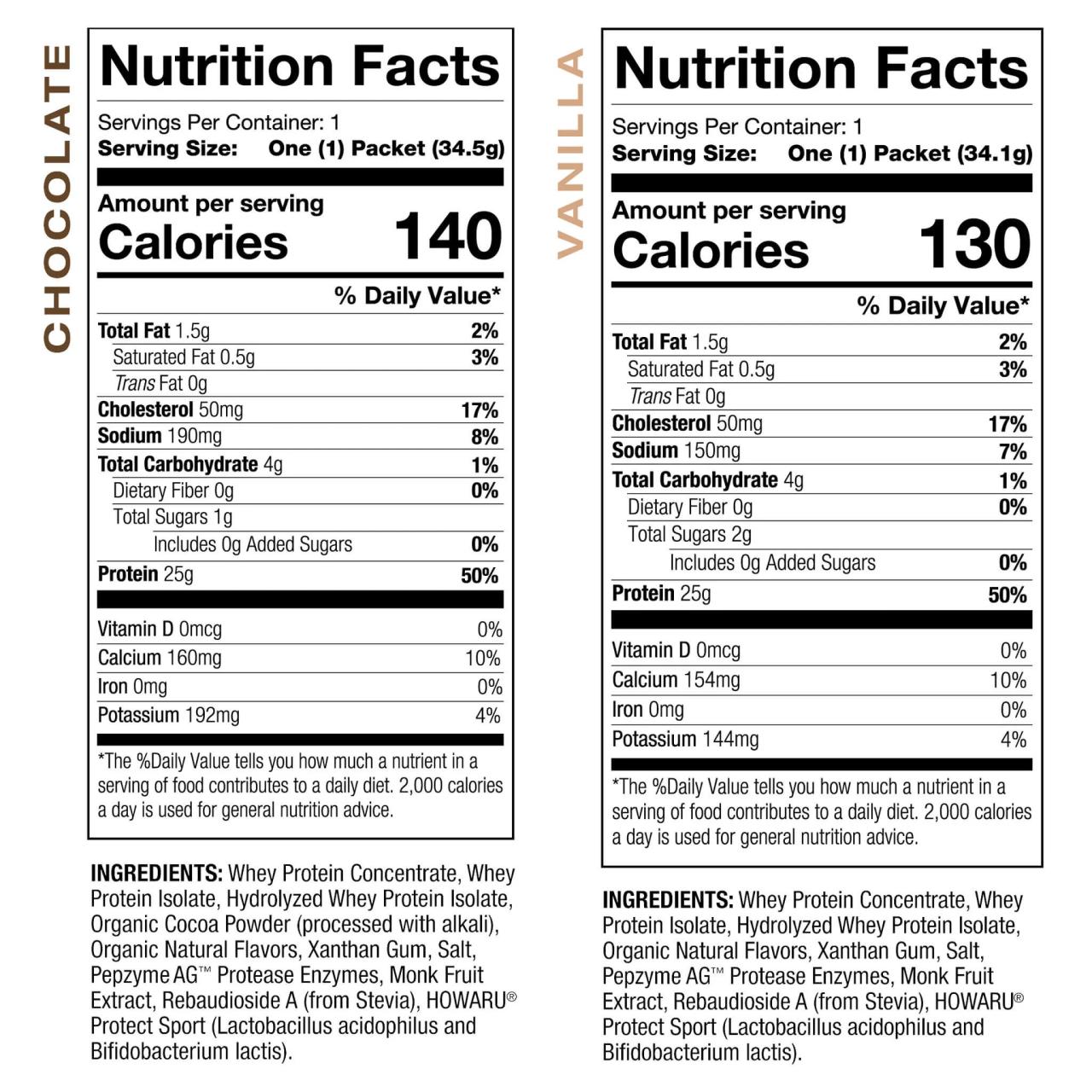Nutritional Composition of Whey Protein

Nutrition facts whey protein – Whey protein, a byproduct of cheese production, is a popular dietary supplement prized for its nutritional profile and ease of incorporation into various diets. Understanding its macronutrient and micronutrient composition is crucial for assessing its value as a dietary addition. This section will detail the nutritional breakdown of whey protein, comparing it to other protein sources and highlighting the benefits of its key components.
Macronutrient Profile of Whey Protein
A typical serving of whey protein powder (approximately 30 grams) provides a significant amount of protein, with a variable amount of carbohydrates and fats depending on the type of whey protein (whey concentrate, isolate, or hydrolysate). Whey concentrate generally contains a higher proportion of carbohydrates and fats compared to whey isolate, which undergoes further processing to reduce these components.
For example, a serving of whey concentrate might contain 20-25 grams of protein, 2-5 grams of carbohydrates, and 1-3 grams of fat, while a whey isolate serving might contain 25-30 grams of protein, less than 1 gram of carbohydrates, and less than 1 gram of fat. These values can vary based on the brand and specific product. The high protein content makes whey protein ideal for individuals aiming to increase their daily protein intake for muscle growth, repair, and overall health.
Micronutrient Content of Whey Protein
While primarily known for its protein content, whey protein also contains various micronutrients. These vary depending on the processing and source of the whey. Whey protein can be a source of several B vitamins, including vitamin B12, riboflavin, and niacin, which are crucial for energy production and metabolic processes. It may also contain small amounts of minerals such as calcium, potassium, and phosphorus, contributing to bone health and overall bodily functions.
However, it’s important to note that the quantities of these micronutrients are generally lower compared to whole foods. The micronutrient profile is often less significant than the macronutrient composition in determining its overall nutritional value.
Right, so you’re checking the nutrition facts whey protein, tryna bulk up, innit? But let’s be real, sometimes you crave a cheeky treat, and that’s where checking out the m&m nutrition facts fun size comes in handy. Knowing the sugar rush before you dive in is proper important, then you can get back to that whey protein shake and your gains, bruv.
Comparison of Whey Protein with Other Protein Sources
Compared to other protein sources, whey protein stands out for its high biological value (BV), a measure of how efficiently the body utilizes the protein for tissue building and repair. Whey protein boasts a BV significantly higher than that of soy protein or casein protein. Casein, another milk protein, digests more slowly than whey, providing a sustained release of amino acids.
Soy protein, a plant-based option, offers a complete protein profile but generally has a lower BV than whey. Egg protein also has a high BV, comparable to whey, but lacks some of the convenience factors associated with whey protein powder. The choice between protein sources depends on individual needs, dietary preferences, and goals.
Benefits of Key Nutrients in Whey Protein
The benefits derived from whey protein are largely attributed to its high protein content and the presence of certain micronutrients. Below is a list detailing these benefits:
- High-quality protein: Supports muscle growth and repair, essential for athletes and individuals focused on building strength and lean mass. This is due to its complete amino acid profile, containing all nine essential amino acids.
- B Vitamins (e.g., B12, Riboflavin): Crucial for energy metabolism, converting food into usable energy. B12 deficiency can lead to fatigue and anemia.
- Calcium: Essential for bone health, preventing osteoporosis and maintaining strong bones throughout life. Adequate calcium intake is particularly important during childhood and adolescence.
- Potassium: Plays a vital role in maintaining fluid balance, muscle function, and nerve transmission. Potassium is also important for regulating blood pressure.
- Phosphorus: Involved in various bodily functions, including energy production, bone health, and DNA synthesis. It works in conjunction with calcium for optimal bone health.
Health Benefits and Applications of Whey Protein

Whey protein, a byproduct of cheese production, offers a range of health benefits beyond its well-known role in muscle building. Its diverse amino acid profile and ease of digestion make it a valuable addition to many diets, contributing to various aspects of overall well-being. Let’s explore some key applications and their associated health advantages.
Whey Protein’s Role in Muscle Growth and Repair
Whey protein is a complete protein, meaning it contains all nine essential amino acids our bodies cannot produce on their own. This makes it particularly effective for stimulating muscle protein synthesis, the process responsible for building and repairing muscle tissue. The branched-chain amino acids (BCAAs) leucine, isoleucine, and valine, present in significant amounts in whey, are especially crucial for this process.
Studies have consistently shown that whey protein supplementation, particularly after exercise, can enhance muscle growth and recovery, leading to increased strength and lean muscle mass, especially beneficial for athletes and individuals engaged in resistance training. For example, a study published in the
Journal of the American College of Nutrition* demonstrated significant improvements in muscle hypertrophy and strength gains in participants supplementing with whey protein compared to a placebo group.
Whey Protein’s Contribution to Weight Management and Satiety
Beyond muscle building, whey protein can aid in weight management. Its high protein content promotes satiety, meaning it helps you feel fuller for longer, reducing overall calorie intake. This effect is partly due to whey protein’s influence on hormones regulating appetite, such as ghrelin (the hunger hormone) and cholecystokinin (a satiety hormone). Furthermore, the thermic effect of protein – the energy expended to digest and process protein – is higher than that of carbohydrates or fats, contributing to increased calorie expenditure.
Individuals aiming for weight loss or maintenance often find whey protein a helpful tool in managing their appetite and caloric intake. A meta-analysis published in
Obesity Reviews* summarized several studies showing that whey protein supplementation can contribute to modest weight loss and fat reduction.
Potential Benefits of Whey Protein for Bone Health and Immune Function
Whey protein also offers potential benefits for bone health and immune function. It contains essential amino acids and minerals like calcium and phosphorus, which are vital for bone structure and strength. Some studies suggest that whey protein may improve bone mineral density, reducing the risk of osteoporosis. Moreover, whey protein’s impact on the immune system is noteworthy.
It contains immunoglobulins and other bioactive peptides with immunomodulatory properties, which may enhance immune response and protect against infections. While more research is needed to fully elucidate these effects, preliminary findings are promising.
Incorporating Whey Protein into a Balanced Diet
Whey protein can be easily incorporated into a balanced diet. It is readily available in powder form and can be added to smoothies, shakes, yogurt, oatmeal, or baked goods. Remember to choose whey protein isolates or hydrolysates for better digestibility and absorption. It’s crucial to consider your individual protein needs based on factors such as activity level, body weight, and overall health goals.
Consulting a registered dietitian or healthcare professional can help determine the appropriate amount of whey protein for your specific needs and ensure its safe and effective integration into your diet. Always prioritize a balanced diet rich in fruits, vegetables, whole grains, and lean protein sources, and view whey protein as a supplementary tool rather than a replacement for whole foods.
Labeling and Ingredient Analysis

Understanding the label on your whey protein powder is crucial for making informed choices about your health and fitness goals. This section will guide you through interpreting the nutrition facts and ingredient list, empowering you to select a product that best suits your needs. We will explore how to decipher the nutritional information and understand the significance of the various ingredients listed.
Interpreting the Nutrition Facts Label
The nutrition facts label provides a snapshot of the nutritional content per serving. A typical label will display the serving size, number of servings per container, and the amount of calories, total fat, saturated fat, trans fat, cholesterol, sodium, total carbohydrate, dietary fiber, total sugars, added sugars, protein, and vitamin and mineral content per serving. Pay close attention to the percentage Daily Value (%DV) listed for each nutrient, which indicates how much that nutrient contributes to your recommended daily intake.
For example, a high %DV for protein indicates a protein-rich supplement, while a high %DV for added sugars might suggest a less healthy option. Consider your individual dietary needs and goals when assessing these values. For instance, a bodybuilder might prioritize high protein content, whereas someone watching their sugar intake would focus on lower added sugar levels.
Significance of Ingredients
The ingredient list, usually found below the nutrition facts, is presented in descending order by weight. The ingredient listed first is the most abundant. Common whey protein ingredients include whey protein concentrate, whey protein isolate, whey protein hydrolysate, and various flavorings, sweeteners, and thickeners. Whey protein concentrate is typically less expensive and contains more lactose and fat than isolates or hydrolysates.
Whey protein isolate undergoes further processing to remove more lactose and fat, resulting in a purer protein source. Whey protein hydrolysate is pre-digested, leading to faster absorption. Understanding these differences helps you choose a product aligned with your preferences and dietary restrictions (e.g., lactose intolerance). Artificial sweeteners, thickeners, and flavorings are also commonly included, influencing the taste and texture of the product.
Be mindful of potential allergens listed, such as soy, nuts, or dairy.
Selecting a Whey Protein Product
Selecting a whey protein product requires careful consideration of both the nutritional information and ingredient list. Prioritize products with a high protein content per serving and a low amount of added sugars, unhealthy fats, and artificial ingredients. Compare the protein content per serving across different brands and types of whey protein (concentrate, isolate, hydrolysate) to determine the best value for your money.
Read reviews and check for third-party certifications to ensure product quality and purity. Consider your dietary needs and preferences, such as lactose intolerance or allergies, when making your selection. For example, individuals with lactose intolerance should opt for whey protein isolate or hydrolysate, which contain less lactose.
Sample Nutrition Facts Label, Nutrition facts whey protein
Imagine a rectangular label divided into two main sections. The top section displays the product name, brand, and serving size (e.g., one scoop, 30g). Below this, a table presents the nutritional information. The first column lists the nutrients (Calories, Total Fat, Saturated Fat, Cholesterol, Sodium, Total Carbohydrate, Dietary Fiber, Total Sugars, Added Sugars, Protein). The second column shows the amount per serving (e.g., 120 calories, 2g fat, 1g saturated fat, 0mg cholesterol, 100mg sodium, 5g carbohydrate, 1g fiber, 3g sugars, 1g added sugars, 20g protein).
A third column displays the % Daily Value (%DV) for each nutrient. Below the table, the ingredient list is presented in descending order by weight, clearly stating each component (e.g., Whey Protein Isolate, Cocoa Powder, Natural Flavors, Sucralose, etc.). This visual representation clearly highlights the key elements for easy comparison among different products.
Question Bank: Nutrition Facts Whey Protein
Is whey protein suitable for vegetarians?
Whey protein is derived from milk, making it unsuitable for strict vegans. However, it is acceptable for lacto-ovo vegetarians.
Can whey protein cause weight gain?
Whey protein itself doesn’t directly cause weight gain. However, consuming excessive calories from whey protein shakes or adding high-calorie ingredients can lead to weight gain.
How much whey protein should I consume daily?
The recommended daily intake of whey protein varies depending on individual factors like activity level, goals, and overall diet. Consulting a healthcare professional or registered dietitian is recommended for personalized guidance.
What are the signs of a whey protein allergy?
Symptoms of a whey protein allergy can range from mild digestive upset (nausea, bloating, diarrhea) to more severe reactions like hives, itching, swelling, and difficulty breathing. If you experience any adverse reactions, discontinue use and consult a doctor.

